During the lockdown, businesses could not work because they did not have tech tools suitable for working offsite. The experience drove home a reality of today; without computerizing your business, you cannot compete.
Many businesses plan to install tech tools so their staff can work from any location. Cloud computing gives small businesses a cost-effective means for doing that.
What is Cloud Computing?
If you use Gmail, Outlook, Yahoo mail, Facebook, you use cloud computing. Cloud computing (the cloud) allows you to use digital services not stored on your computer. You must have an internet connection to access the cloud.
Why is Cloud Computing Important?
The cloud gives businesses access to computer resources that they might not be able to buy outright. The benefits the cloud gives you are:
- Flexibility– Cloud computing solutions are very scalable. Start with just what you need and scale up as your needs increase.
- Disaster recovery– losing vital business data when disaster strikes can badly affect your business. When your data is in the cloud, you can retrieve it to restart your business in a short time.
- Automatic updates – using the cloud takes off the stress of maintaining your servers. You always get the latest and most secure version of the software pushed to your servers automatically.
- Reduced costs– cloud computing is a pay-as-you-go model; you invest in what you need at any time. It costs a lot more when you buy and install the software yourself.
- Collaboration– using the cloud allows your staff to access and share data. It makes working together on a project, wherever they are, easy.
- Security– if your team works safely in the cloud, keeping data in the cloud is more secure than having the data stored locally. Also, with two-factor authentication and stronger security measures in place today, keeping data in the cloud is a much safer process.
- Access from anywhere– once your workers have access to the internet, they can use your cloud solutions anywhere they are. This allows you to hire experts from around the world, without the expense of relocation.
- Document control– when users use documents on a computer drive, for ease of access they may make and work on copies of the document. Over time, you end up with different versions of the document, and it is hard to tell which is the most current. When you store the document in the cloud, users access the same document, so you avoid users creating different versions.
Common Problems
While the cloud may be the ideal solution for your business, it is not without concerns.
The concerns are:
- Downtime– you must have a reliable internet connection to use cloud computing. If your internet service is slow or frequently unavailable, cloud computing may not be suitable for your business.
- Increasing costs- although the initial cost of cloud ownership is lower than a traditional onsite solution, as the service grows so can the cost to the business.
- Cloud provider outage- sometimes there may be problems and the cloud system may not be available. This may stop you from working. Reputable systems do not go off for too long.
- Contract woes– a vendor’s terms and conditions are standard without room for negotiating it. You may agree to contracts without understanding the implications.
- Locked into the cloud vendor– some vendors deliberately try to “lock-in” customers by using proprietary software, making it expensive to switch to another vendor.
- Hacking– cloud computing is very secure, but sometimes hackers steal and leak data to the world. Choose a vendor with a reputation for strong security.
- Online helpdesk– using a cloud provider means your technical support is handled elsewhere. If the vendor is not responsive, you could be held up and cannot work until they respond.
Take Away
Cloud computing gives access to expensive, hi-tech tools that enable your staff to work together from any location in the world. It addresses an important need in this era of pandemics and lockdowns.
For more blogs and information please follow SCG Chartered Accountants on Facebook, Twitter, Youtube and LinkedIn.

